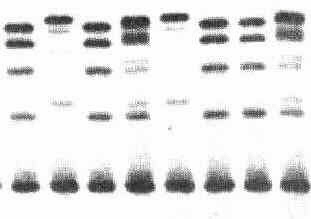

Picture to the left: Isoenzyme pattern of lactate dehydrogenase (LDH) in heart tissue of embryonic, iuvenile and adult mice. The six rows show the pattern -9, -5, -1 days before birth as well as +12 and +21 days after birth and in adult mice.
Picture to the right: Variations of the leucine-amino-peptidase (LAP) in snails. Each row corresponds to a probe of one animal each. The patterns are specific for every individual.
Before starting let us recall quickly:
If a gene exists in a heterozygous state, two different polypeptide chains will be generated. They may be separated by gel electrophoresis under favourable conditions. They may also differ in their rate of substrate turnover. The gene product a, for example, may be inactive while that of A is fully active. But all states in between are also possible. Furthermore, it was shown in numerous examples that A may be favourable under certain environmental conditions while a is favourable under other conditions (more in the section about evolution). Polypeptides (enzymes) that are encoded by different alleles are called alloenzymes.
By duplication of the genetic materia,l a gene may be present within a haploid genome for two or more times. It is not important whether the gene loci are on one chromosome or distributed over several chromosomes. The gene products (enzymes) of the different gene loci (pseudoalleles) are called isoenzymes.
Many enzymes are known to have isoenzymes. They may differ in substrate turnover or in the ability to be regulated. Their occurrence is either restricted to certain organs or certain steps of development.
The existence of one isoenzyme does not exclude that of a second or third or even more. Often, only quantitative shifts can be found in the relation of one to the other. Different isoenzymes have usually been found in different compartments (plastids, mitochondria, cytosol).
Gel electrophoresis alone cannot distinguish between allo- and isoenzymes. For the study of alloenzymes, different individuals of one species are necessary. The same cells have to be compared and it has to be proceeded in the same way as in a genetic analysis of factors behaving in an Mendelian way. For the detection of isoenzymes, in principle just one individual is necessary since each individual of a species has kthe same pattern of distribution.
Alloenzymes are good markers for studies of population genetics, isoenzymes for development physiological ones.

A. Iso- and alloenzymes of the leucine amino peptidase of corn. The isoenzyme distribution is organ-specific. The alloenzymes (marked in the picture by brackets) are products of different alleles (according to J. L. BREWBAKER, M. D. UPADHYA, Y. MÄKINEN and T. MacDONALD, 1968)
B. B. Polymorphism of peroxidase. Iso- and alloenzymes of corn. The isoenzyme distribution is organ-specific. The alloenzymes (marked in the picture by brackets and numbers) are products of different alleles (according to D. E. HAMILL and J. L. BREWBAKER, 1969)
|
|